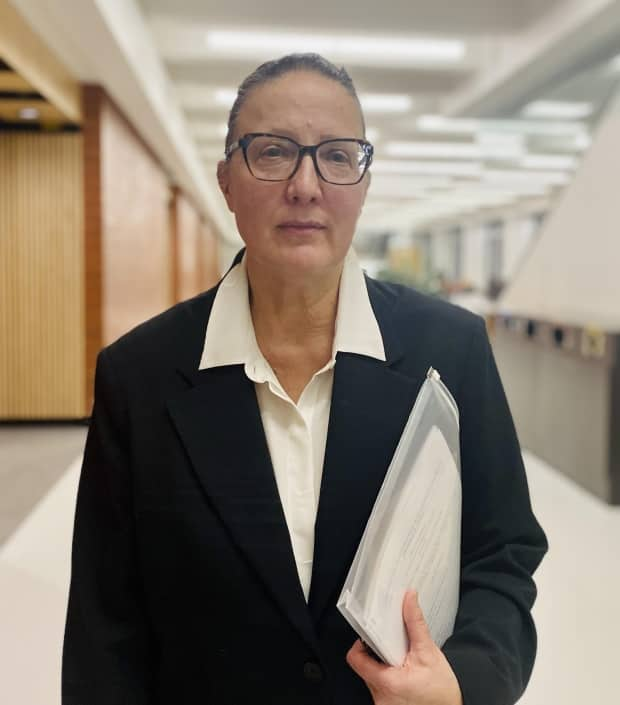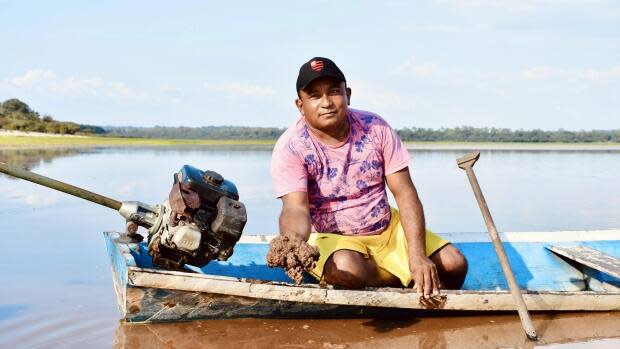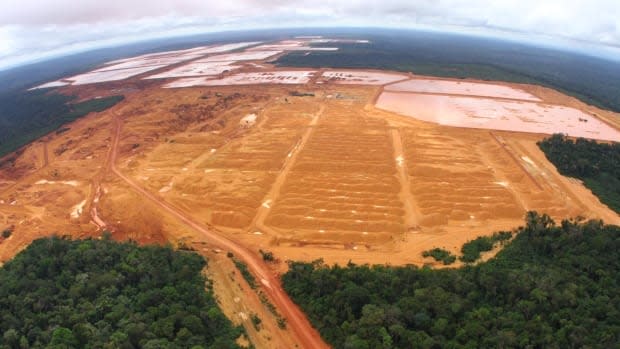Rio Tinto says it's a green mining giant. Investigation shows environmental gaps from Quebec to the Amazon

At times, Rio Tinto has spilled dangerous chemicals at several of its Quebec sites without disclosing it to the provincial government — behaviour that contradicts the multinational's brand as an eco-friendly business.
Documents obtained by Radio-Canada's Enquête program through an access-to-information request reveal more than 100 environmental infractions doled out to Rio Tinto's aluminum division in Quebec over the past 15 years.
The company has also paid $2.1 million in fines in that same period, making it the third biggest environmental offender in the province.
The company was fingered eight times for either neglecting or waiting to report problems related to pollution to Quebec's Environment Ministry. The documents include infractions for obstructing the work of public officials and failing to provide mandatory documents when required.
These infractions took place at Rio Tinto's massive Complexe Jonquière, and other nearby sites located around the city of Saguenay. The Complexe Jonquière is an industrial site that employs 1,500 people. It includes two aluminum plants, and various other refining, chemical and research facilities.

Rio Tinto's environmental missteps have come just as the company amasses tens of millions of dollars in public money.
Enquête also corroborated the company's spotty environmental record through a whistleblower who works at the Jonquière complex and whose identity it agreed to protect due to fear of professional reprisals.
In addition to looking into Rio Tinto's environmental practices in Quebec, Enquête also travelled to the heart of the Amazon forest in Brazil — to a mine in which Rio Tinto has a 22 per cent stake. It is where the company sources some of its bauxite.
There, local residents expressed their concerns about the mine's effects on the environment and the long-term health of people who live near it.
'We hide things all the time'
According to the whistleblower, the company has often resorted to hiding spills and altering a substance's colour by using gravel or dirt.
"We hide things all the time, and sweep them under the rug. It will take time to see all the things that are hidden, but it's starting to come out," says the source.
"Only the severity of the fine can make the company react."
Rio Tinto declined our interview requests. In an email, it denied these allegations.
Rio Tinto Aluminium said "it operates with a strict culture of environmental compliance which includes reporting spills to the competent authorities."
"If an incident occurs, it is thoroughly investigated and corrective measures are put in place to prevent it from recurring," the company said.

In a letter made public on Friday, Rio Tinto says allegations of cover-ups, obstruction or delays are "not our values and this is not how we behave."
"Our 4,300 employees in Saguenay-Lac-Saint-Jean, like those around the world, are concerned about the legacy they will leave to their children," the letter states.
The industry has for years emphasized its green bonafides by claiming it uses clean hydroelectricity. Quebec aluminum plants emit less carbon dioxide than plants in China and elsewhere that are powered using coal.
But critics say plans that could have further reduced Rio Tinto's carbon emissions sooner were either never implemented or only materialized much later than promised.
"Investments [were promised] to modernize all the plants, which were outdated, aging, polluting and at the end of their useful lives," said Jacques Dubuc, who is now retired and used to work as a spokesperson for Alcan, which was bought by Rio Tinto in 2007.
He said "we have a history of broken promises, partially kept promises, with excuses or tricks to try to prolong the life" of aging plants.
In 2007, with talks brewing about the implementation of a cap-and-trade system in Quebec for carbon pollution, "green aluminum" started to become a common industry term. Aluminum producers that were among the province's biggest polluters were expected to have to start paying into the scheme which would have had an impact on profits.
But by playing up the concept of green aluminum behind the scenes, those companies were able to get exemptions, according to Marie-Claude Prémont, a professor at the École nationale d'administration publique.
"Green aluminum is a marketing tool," she said.
"It's a label that was assigned to an industry that barely changed in the last few decades."
According to Prémont, "the public needs more than just marketing" to understand what is going on and to make informed decisions.

Rio Tinto, with its four aluminum smelters and its alumina refinery, still ranks among the province's 20 biggest polluters, and since 2007 its CO2 emissions have hardly budged.
In 2018, Elysis, a joint venture that includes Rio Tinto and Alcoa, was established as a research initiative meant to create aluminum with a zero carbon footprint. Since then, the Quebec and Canadian governments have doled out $160 million in subsidies.
On its website, Elysis claims it is developing a "revolutionary" and "disruptive" technology, even calling it "non-polluting" aluminum. But the technology that was supposed to come into large-scale production in the mid-2020s has quietly been pushed back to beyond 2030.
In an email, Elysis did not divulge its new timetable, saying it was concentrating on research and development.
Even if Elysis was fully implemented, between 1.3 and two tonnes of CO2 are generated per tonne of aluminum. That's because bauxite has to be extracted, shipped and refined to alumina before it is made into aluminum — and each part of that process has a carbon footprint.
The wide margin of CO2 produced depends on whether the alumina is refined in Quebec or imported.
Rio Tinto will testify before a Parliamentary committee in Ottawa in April to provide an update on its program. It also says that a commercial prototype will come out later this year.
The company also says it is working systematically to further reduce emissions at each production stage.
The aluminum industry is expected to grow worldwide by almost 40 per cent by 2030 due largely to increased demand from electric car manufacturers.

Tracing the production chain back to Brazil
Much of the bauxite used by Rio Tinto comes from a mine in the heart of the Amazon forest.
"To claim that your product is green is very serious, given the bauxite production chain. How can you call clearing the forest green? How can anyone say that digging up the soil is green?" asks Lilian Braga, a public prosecutor who works in the Amazonian state of Para near the mine run by Mineracao Rio Do Norte (MRN).
That ore deposit was discovered by Montreal-based Alcan in the 1960s. The mine has been shipping industrial quantities of bauxite to Quebec since 1979.
Because of the mine, "people sometimes get sick," according to local activist Carlos Printes whose family has lived near the MRN owned mining town of Porto Trombetas for many years.
"Many people fall ill because of the company. But they do nothing for these people," he said.
Although there are no long-term public health studies that confirm this, other people living near the mine repeated these claims.
"People who drink this water get diarrhea and stomach aches. We can see that this is a water-related problem because not everyone has a well," says Raymundo Wilson, a village head who lives near Lake Batata.

MRN dumped 18 million cubic metres of bauxite residue into the lake from 1979 to 1989 in what some consider to be one of the most glaring cases of industrial pollution in the Amazon at the time. He told us that 60 out of 120 families living around the lake still don't have access to filtered well water.
Heavy metals such as lead, arsenic and mercury can be released after bauxite is extracted from the ground. These can also get into water sources. Locals also worry about how safe the tailings dams are. These are similar to wet landfills and MRN has 29 of them where it put the tailings produced after bauxite was washed.
MRN's director of sustainability Vladimir Moreira told Enquête that mine tailings are inert and that there is no danger to human health. Asked if he would eat local fish, he replied: "Of course I would."
The company says it has "around 250 monitoring stations for water, air and noise quality. And all these stations show that there is no contamination."
"Our waste management system is absolutely safe," Moreira said. He added that the mine follows international standards and local communities participate in mine safety protocols.
In its open letter, Rio Tinto says it also works with MRN to ensure best practices are followed to improve environmental and social performance. These include robust reforestation efforts, and closely monitoring water quality and dam stability as well as health and education services to local communities.
Brazil has had a history of tailing dams ruptures with Mariana in 2015 and Brumadinho in 2019, which killed 19 and 272 people respectively. The latter had a type of dam construction known as upstream.
Vale, the company that owned the Brumadinho mine and was a 40 percent shareholder of MRN until 2023 said in a 2020 statement to the Security and Exchange Commission that MRN had dams similar to those at Brumadinho.
The rupture of any of these structures could cause loss of lives and serious personal, property and environmental damages," Vale said in its statement.

Jose Domingos, a farmer who lives near Lake Sapucua, which is downstream of the dams, says the threat of an environmental disaster constantly hangs over local communities.
"If one day, there is a possible problem for the 16 communities of Lake Sapucua, it's over for us, you understand?" Domingos said. "We can't sleep at night during the winter, because it rains so much."
MRN commissioned studies that allowed it to get its dam classifications changed with the Brazilian government's mining oversight body. Dams that were classified as upstream, a category widely considered more dangerous, were given a different designation.
Moreira says the geography where MRN has its tailings reservoirs is different from what existed in Mariana and Bruhmadino.

But at least one expert questions those reclassifications.
If there's any doubt about a dam, a preventative approach should be used to "ensure the protection of people and the environment," said Andressa Lanchotti, who sat on the prosecution team in the Bruhmadino case.
Rio Tinto says it is aware of the concerns associated with bauxite mining in Brazil.
"We are working tirelessly to improve our operations by promoting a circular economy and furthering the environmental, social and governance best practices throughout our entire supply chain, from mine to consumer," said Nina Mankovitz, vice-president at Rio Tinto Aluminium.

Billions in subsidies and financial benefits in Quebec
"To call it green aluminum is greenwashing," said Martine Ouellet, a former Quebec minister of natural resources who now heads a small political party dedicated to fighting climate change.
Ouellet, who was also head of special projects at Hydro-Québec, estimates that with greenhouse gas fee exemptions, tax rebates and through use of their privately-owned dams, Rio Tinto gets about $1.2 billion a year in subsidies.
Rio Tinto says that most of the projects it initiated since 2020, totalling $2 billion in investments, did not get government subsidies.
Elysis has gotten buy-in from major brands like Apple, Michelob and BMW, who plan to purchase this product once it is available.
But the aluminum industry is asking for even more funding.
In early March 2024, the Aluminium Association of Canada asked the Quebec government to continue subsidizing electricity for aluminum and for more investments in Elysis. These subsidies and financial benefits could cost taxpayers further billions over the coming years.


